Discover how OpenAI’s Sora is revolutionizing text-to-video generation with its groundbreaking capabilities and ethical approach.

Unveiling Sora: OpenAI’s Groundbreaking Generative Video Model
In the realm of artificial intelligence, OpenAI continues to push boundaries with its latest creation, Sora. This innovative generative video model represents a significant leap forward in text-to-video generation technology. By translating short text descriptions into detailed, high-definition video clips lasting up to a minute, Sora promises to revolutionize the way we create and interact with visual content.
Text-to-video generation has emerged as a hot research direction in AI, and OpenAI’s Sora exemplifies the progress being made in this field. Tim Brooks, a scientist at OpenAI, emphasizes the importance of developing models that can comprehend the complexities of video, including intricate interactions within our environment. Sora’s capabilities signal a pivotal advancement in AI systems’ ability to understand and interpret visual data.
Also Read :- Fani Willis Testifies: Trump Prosecution Drama
OpenAI’s decision to unveil Sora to a select group of safety testers underscores the company’s commitment to responsible AI development. While the model’s capabilities are impressive, OpenAI remains cautious about potential misuse, particularly concerning the creation of fake but photorealistic videos. Aditya Ramesh, a scientist at OpenAI, highlights the importance of thorough safety testing and careful deployment to mitigate risks associated with such advanced technology.
Sora builds upon the foundation laid by earlier text-to-video models, incorporating cutting-edge techniques to enhance its performance. Unlike previous models, Sora combines a diffusion model with a transformer neural network, enabling it to process video data in a manner akin to processing textual data. This novel approach allows Sora to analyze and generate videos across various dimensions, including resolution, duration, aspect ratio, and orientation, expanding its versatility and effectiveness.
The transformative potential of Sora extends beyond its technical capabilities to its implications for content creation and storytelling. By democratizing video production, Sora empowers individuals to express themselves creatively through visual media. Sam Gregory, executive director at Witness, recognizes the dual nature of this advancement, acknowledging both its expressive potential and the risks of misuse.
As with any emerging technology, the deployment of Sora necessitates rigorous safety measures and ethical considerations. OpenAI is proactive in addressing these concerns, implementing filters to prevent the generation of inappropriate content and embedding metadata to track the origins of generated videos. However, challenges remain, highlighting the ongoing need for collaboration and feedback to refine and improve Sora’s safety features.
Also Read:- Russia’s Space-Based Nuclear Weapon Threat
Looking ahead, OpenAI aims to leverage insights gained from safety testing to further enhance Sora’s capabilities and ensure its responsible deployment. The company’s commitment to transparency and collaboration underscores its dedication to advancing AI technology in a responsible and ethical manner.
In conclusion, OpenAI’s unveiling of Sora represents a significant milestone in the evolution of text-to-video generation technology. With its groundbreaking capabilities and commitment to safety and ethics, Sora holds the potential to revolutionize the way we create, consume, and interact with visual content in the digital age.
